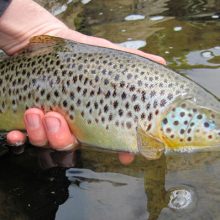This article may contain affiliate links. If you make a purchase after clicking on a link we may earn a small commission at no extra cost to you. As an Amazon Associate, I earn from qualifying purchases.
Rooster Tail for Trout

Look in almost any trout tackle box from the last fifty years and you are likely to find at least a few rooster tail lures.
Rooster Tails for trout have been the go to on small rivers and streams and have caught thousands of fish all over the world.
These small inline spinners can be fished in very shallow water but tend to need at least three foot in depth to get the best out of them.
It’s flashing blade is a great attractor both visually and from a vibration standpoint, whereas the rear hackle give a very realistic movement and helps to hide the treble hook from easily spooked trout.
The Best Rooster Tail for Trout
When it comes to choosing the best Rooster Tail for trout will generally be determined by the type of water you are fishing, time of year and the general weather conditions on the day. However some patterns are very reliable:
- Black
- Chartreuse
- Firetiger
- White
Trout will generally respond best to the most abundant food source that is in front of them. For example if there is a large number of nymphs moving from the bottom to the surface to hatch into some for of adult insect then a picky trout will ignore pretty much anything else you put in front of them.
“Matching the hatch” is certainly true if you are fly fishing but it can also be replicated when using a trout lure such as a Rooster Tail.
In darkened waters where trout are hunting with sound and vibration more than sight a flashier Rooster Tail with a bright blade and a fluorescent hackle can be far more productive than a natural patterned one.
And conversely if there is a lot of insects about on a clear day then using a darker more natural pattern will best. In these instances the brighter lures may actually spook fish.
What Size Rooster Tail for Trout?
In general you need to match the size of the Rooster Tail lure to the body of water you will be fishing. On an ultralight combo on a small river your best bet would be to stick with the following sizes:
- 1/32 ounce
- 1/24 ounce
- 1/16 ounce
These smaller sizes mimic the size of a trout food better. Larger lures will also sink much quicker so you may end up snagging on the bottom more often.
If you happen to fishing a much large river that is 10 feet or deeper or are planning on trolling for trout then you can use some of the larger sizes that are available.
Rooster Tail Colors
Rooster tails are pretty simple lures just like any other spinners. Color selection is probably the most difficult thing to get right when fishing a Rooster Tail.
The colors that you choose as mentioned earlier will be generally be determined by the weather and light conditions on where you are fishing.
The selection runs between the two extremes of:
- Duller more natural patterns/colors imitators
- Artificial fluorescent/shiny attractors
Some of the most popular colors are chartreuse, black, white and dark green or olive with the classic gold and silver blades.
There are a lot of different color combinations available across the range. There are generally two things to consider when choosing a Rooster Tail lure:
- Blade color
- Hackle color
Blade Selection
The classic blade colors are either silver or gold. However, there are some patterns available that are painted onto the blade that can be used to imitate the natural spots in smaller bait fish the live in rivers.
Blade color is best determined by light conditions. A black, silver or gold blade on brighter days or in really clear waters. And, on duller days or dark run waters you can use some of the brighter artificial colors.
Hackle Color
The hackle can act as a great imitator and it is what ultimately gives the Rooster Tail lure an edge over more simple spinners such as a Mepps.
Again on bright days aim to use the darker more natural colors such as black or olive and in low light scenario’s you can opt for something a little brighter.
Rooster Tail Fishing for Trout
Just like using most other spinners Rooster Tail fishing is all about using light trout fishing tackle to get the most accurate and delicate casts. Precision is key and accurately casting a Rooter Tail to put it right upstream of a trout is what will be most effective.
If you are fishing a new stretch of water try to cast from one bank to the other in a fan like pattern. This will allow you to cover the most water.
Be on the look out for sunken tree branches, deep pockets/holes and where faster moving water meets slower water particularly on bends in the river. Working these lures a few feet upstream of a trout as it lies in wait for it’s next meal is the most effective approach to fishing with a Rooster Tail lure.
Setup
A fairly standard light to ultralight spinning setup can be used with a Rooster Tail spinner.
Rod – 5.5 to 7 foot trout rod depending on how big the stretch of water is that you are fishing. Look to have a light to ultralight power rating with a fast action.
Reel – A good trout fishing reel to use when using a light setup is a size 1000 up to 2500.
Line – Usually mono in the 2 to 6 pound range.
